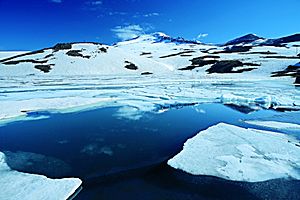Lake Kari facts for kids
Lake Kari (which means Stone Lake in Armenian, and is written as Armenian: Կարի լիճ) is a special lake found high up in the mountains of Armenia. It sits on the slopes of Mount Aragats, which is the tallest mountain in the country. This lake is mostly created by the melting ice and snow from the mountain peaks.
Contents
What is Lake Kari Like?
Lake Kari is a freshwater lake, meaning its water is not salty. It is known for its clear, cold water, which comes directly from the mountain's snowmelt. Because it is so high up, the lake can be frozen for much of the year. It is a popular spot for scientists who study the weather and the environment.
Where is it Located?
Lake Kari is nestled on the southern side of Mount Aragats. Mount Aragats is an ancient volcano and the highest point in Armenia, reaching over 4,000 meters (about 13,000 feet) above sea level. The lake itself is located at an elevation of about 3,200 meters (around 10,500 feet). This high altitude means the area around the lake has a unique climate and landscape.
How Does it Form?
The main way Lake Kari gets its water is from the melting snow and ice that cover Mount Aragats. During the warmer months, the snow and glaciers on the mountain begin to melt. This meltwater flows down the slopes and collects in the natural basin where Lake Kari is located. This process is common for many mountain lakes around the world, making them important sources of fresh water.
Life Around the Lake
Even though Lake Kari is high up and often cold, life can still be found there. The plants and animals that live in this environment are specially adapted to the harsh conditions.
Plants and Flowers
Around the lake, you might find tough mountain grasses and small, hardy plants. During the short summer, colorful alpine flowers can bloom, adding splashes of color to the rocky landscape. These plants often grow close to the ground to protect themselves from strong winds and cold temperatures.
Animals and Insects
Animals like mountain goats or various birds might visit the lake for water. You might also see different types of insects, especially during the warmer months. The cold water of the lake itself might support certain types of tiny aquatic life, like small insects or algae, which form the base of the food chain.
Why are Mountain Lakes Important?
Mountain lakes like Lake Kari are very important for several reasons. They are natural reservoirs that store fresh water, which can then flow down to lower elevations and be used by people and wildlife. They also play a role in the local ecosystem, providing habitats for unique plants and animals.
Natural Beauty and Research
Besides their practical uses, mountain lakes are incredibly beautiful. They offer stunning views and a sense of peace. Lake Kari is also important for scientific research. Scientists often study these high-altitude lakes to understand climate change, as changes in snowmelt and ice can directly affect the lake's size and temperature.


